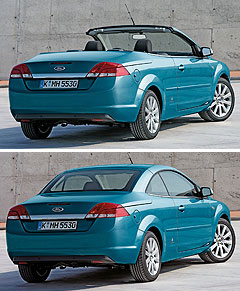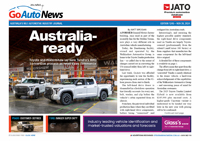Make / Model Search
Future models - Ford - Focus - CCFocus CC: Open all hoursSassy: Ford hopes convertible Focus will join XR6 as a "halo" model here. Focus Coupe-Convertible set for London debut - and a possible 2007 intro Down Under12 Jul 2006 SALES of the Focus Coupe-Cabriolet will start in Europe from October following a global debut at the British International Motor Show in London this month, however it is still to be confirmed for sale in Australia. "It is definitely a car that we’re interested in, but we don’t have approval for it," Ford Australia public affairs manager Sinead McAlary told GoAuto this week. "If we did get approval then the Coupe-Convertible, like the XR5 Turbo, would be here as a halo model for the rest of the Focus range." GoAuto understands that Ford Australia is pulling out all stops to try and make the Focus convertible available here and that an arrival in the second half of next year is likely. Developed in conjunction with the Volvo C70 coupe-convertible, the Focus CC is built on the C1 Focus four-door sedan platform that also underpins the Mazda3 sedan and Volvo S40. Production has just started near Turin in Italy by coachbuilders Pininfarina, who also produced the Vignale concept car that heralded the Coupe-Cabriolet at the Paris motor show in 2004. Around 20,000 units are to be produced annually, using parts that are sourced mostly from Ford’s Saarlouis plant in Germany – the same site where our XR5 Turbo is made. All other Australian-bound Focuses are out of South Africa. Besides its two-door body shape, the chop-top Focus has a new front bumper, redesigned tail-lights and remoulded wheel arches to differentiate it from the small Ford’s humbler hatchback, sedan and wagon siblings. A four-seater, the cabin’s main party trick is a two-piece folding metal roof that takes 29 seconds to open or close. The Coupe-Cabriolet also boasts the biggest boot in its class – 534 litres roof up, and 248 litres with the hardtop stowed. Three twin-cam 16-valve four-cylinder engines are available from launch. Unlikely for Australia is a 74kW 1.6-litre petrol unit related to the one found in the current model Fiesta. In this application it takes 13.6 seconds to hit 100km/h from standstill on the way to an 183km/h top speed. The mid-range, and probable sole, powerplant choice for Australia is a 2.0-litre petrol engine, delivering outputs identical to the units powering the current Focus range locally.  For the record, in the regular models, they are 107kW of power at 6000rpm and 185Nm of torque at 4500rpm, with 90 per cent of the latter occurring at 2000rpm. The larger of the petrol-powered pair takes 10.3 seconds in the 0-100km/h sprint, and tops out at 209km/h. For the record, in the regular models, they are 107kW of power at 6000rpm and 185Nm of torque at 4500rpm, with 90 per cent of the latter occurring at 2000rpm. The larger of the petrol-powered pair takes 10.3 seconds in the 0-100km/h sprint, and tops out at 209km/h.In Australia the conceptually similar Renault Megane Coupe-Cabriolet and Peugeot 307 CC also use 2.0-litre petrol motivation – a 98kW/191Nm engine in the former, while the latter offers a choice of a 100kW/190Nm or 130kW/202Nm unit. In contrast, the 100kW/320Nm 2.0-litre TDCi turbo-diesel engine that Ford has co-developed with Peugeot/Citroen is likely to be Europe’s favourite in this car, as well as the choice for performance and economy-minded sun-seekers alike. Also taking 10.3 seconds to 100km/h, the diesel concedes just 3km/h in the maximum velocity stakes, yet averages around 5.9L/100km against the 2.0-litre petrol engine’s 7.5L/100km and 1.6’s 7.1L/100km. Adding another feather to the diesel’s cap is its six-speed manual gearbox against the others’ five-speeders. As in all LS Focus models, a MacPherson strut front and multi-link rear suspension system is in place, as is an electro-hydraulic power steering set-up. Ford has also carried over much of the regular Focus’s cabin, save for a bevy of new trim and fabric implementations designed to lift the car’s ambience and perception of quality. To this end, the interior is finished in either light or dark contrasting shades. Protecting its occupants is a variation of Volvo’s Rollover Protection Device system that, when detecting an imminent roll, fires up a pair of roll bars from behind the rear seats. They extend out 20cm, and are backed up by "ultra strong" windscreen pillars. All future models Alfa Romeo Alfa Romeo Abarth Abarth Alpine Alpine Alpina Alpina Audi Audi Aston Martin Aston Martin BMW BMW Bentley Bentley Chery Chery Brabham Brabham Chrysler Chrysler Chevrolet Chevrolet Cupra Cupra Citroen Citroen DS DS Dodge Dodge Fiat Fiat Ferrari Ferrari Foton Foton Ford Ford Great Wall Great Wall FPV FPV Haval Haval GWM GWM Honda Honda Holden Holden Hummer Hummer HSV HSV Infiniti Infiniti Hyundai Hyundai Jaguar Jaguar Isuzu Isuzu Kia Kia Jeep Jeep Land Rover Land Rover Lamborghini Lamborghini Lexus Lexus LDV LDV Mahindra Mahindra Lotus Lotus Mazda Mazda Maserati Maserati Mercedes-AMG Mercedes-AMG McLaren McLaren MG MG Mercedes-Benz Mercedes-Benz Mitsubishi Mitsubishi Mini Mini Opel Opel Nissan Nissan Peugeot Peugeot Pagani Pagani Proton Proton Porsche Porsche Renault Renault Ram Ram Rover Rover Rolls-Royce Rolls-Royce Skoda Skoda Saab Saab SsangYong SsangYong Smart Smart Suzuki Suzuki Subaru Subaru Toyota Toyota Tesla Tesla Volvo VolvoFocus pricing
Motor industry news |
Click to shareFord modelsResearch Ford All future models Alfa Romeo Alfa Romeo Abarth Abarth Alpine Alpine Alpina Alpina Audi Audi Aston Martin Aston Martin BMW BMW Bentley Bentley Chery Chery Brabham Brabham Chrysler Chrysler Chevrolet Chevrolet Cupra Cupra Citroen Citroen DS DS Dodge Dodge Fiat Fiat Ferrari Ferrari Foton Foton Ford Ford Great Wall Great Wall FPV FPV Haval Haval GWM GWM Honda Honda Holden Holden Hummer Hummer HSV HSV Infiniti Infiniti Hyundai Hyundai Jaguar Jaguar Isuzu Isuzu Kia Kia Jeep Jeep Land Rover Land Rover Lamborghini Lamborghini Lexus Lexus LDV LDV Mahindra Mahindra Lotus Lotus Mazda Mazda Maserati Maserati Mercedes-AMG Mercedes-AMG McLaren McLaren MG MG Mercedes-Benz Mercedes-Benz Mitsubishi Mitsubishi Mini Mini Opel Opel Nissan Nissan Peugeot Peugeot Pagani Pagani Proton Proton Porsche Porsche Renault Renault Ram Ram Rover Rover Rolls-Royce Rolls-Royce Skoda Skoda Saab Saab SsangYong SsangYong Smart Smart Suzuki Suzuki Subaru Subaru Toyota Toyota Tesla Tesla Volvo VolvoFocus pricing
Motor industry news |









Facebook Twitter Instagram